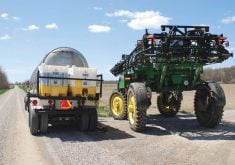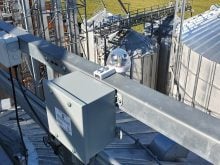ST. PAUL, Minn. – One steering axle on a sprayer, given enough wheel clearance, can turn pretty tight. Two steering axles can make the operator think the machine will run over its own cab.
RoGators for 2011 are available with the GatorTrak all-wheel steering option, shrinking their turning radius to 13.5 feet from 23 feet.
Introduced about eight years ago, all-wheel steering on Chevy pickups proved to be nothing more than a passing fancy. Since then, agricultural equipment manufacturers began putting it on heavy grain carts, air seeder tanks and liquid caddies.
Read Also

Geopolitics can change trade routes
WHISTLER, B.C. — Today’s geopolitical tensions could have dire long-term consequences, says the director of international policy at the University…
GatorTrak on the five RoGator models is more than a passing fancy, according to Agco’s John Lipscomb. The two main benefits are better use of space in the field and less crop damage.
He said economic factors have forced producers to farm fence row to fence row and corner to corner. This creates a number of turning and compaction problems in the headlands.
“But, if you can come straight out of your field at the end of a run and make a quick turn on the road, you’ve solved a lot of those space problems.
“You can’t do that unless you have all-wheel steering.”
Lipscomb said an extreme example of this strategy is found in the rice fields in the southern states. Sprayer operators run down the field and onto the levy for their turns.
They don’t turn while the sprayer is in the headland or in the field, so there is less rice damage and less chance of getting stuck.
Muddy conditions experienced in Western Canada in recent years are similar to the rice paddies.
Although systems like GatorTrak have their best payback in high value crops, Lipscomb said wheat growers are also catching on to the idea of using all-wheel steering to eliminate headland turns.
“They spray one pass all the way around the field, then let AccuBoom turn off the appropriate nozzles to prevent overlap.”
When time is tight, this allows the operator to finish each field in less time, he said.
Reducing crop damage is the second advantage of four wheel steering on high clearance sprayers, said Lipscomb.
“With conventional steering, every time I turn at the end of a field, I end up leaving four sets of tracks.
“With all-wheel steering, I only leave two track sets of tracks in the headlands and I’ve eliminated much of the side scuffing, ridging, rutting and compaction.”
With soft fields inevitable next spring, producers will be looking for any advantage to reduce rutting.
Split drive hubs are the other RoGator improvement for 2011.
Lipscomb conceded that some other manufacturers had already made this move. Agco decided to do the split because of cost, reliability and maintenance.
“When we had the hydrostatic motor and power hub all together as one unit, we also had the parking brake and other things inside the same unit.
“Now, by splitting those two assemblies, the hydrostatic motor runs cleaner and is totally separate from the power hub.
“One wheel assembly used to cost $10,000 to replace. Now, the total replacement is about $6,000. But because they are separate units now, you should never need to replace the whole thing.”
Lipscomb said the hydrostatic motor by itself costs $2,500. The gear assembly costs $3,500, which includes the parking brake.
Large disc brakes are integral at the front hubs to supplement the regular hydrostatic brakes.
Agco has also standardized the drive hubs on all RoGator models except the largest.
All five RoGator models have seven speed ranges to help the operator match speed to field conditions. In the first range, power is distributed equally front and rear for better traction in muddy conditions.
The power split changes with higher speeds to reduce wheel hop in transit, reducing it to 1,950 r.p.m. from 2,100 r.p.m.
The new RoGator lineup extends from the 250 h.p. 994H with 900 gallon capacity up to the 311 h.p. 1396 with 1,300 gallons.















